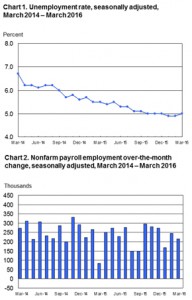Employment Summary for
March 2016
Employment rose alongside wages in the U.S., solidifying March as another strong month for the labor market.
Job gains continue
The U.S. added 215,000 nonfarm payroll positions in March, while the unemployment rate registered a slight increase, rising to 5 percent from 4.9 percent in February.
The March job gains surpassed Bloomberg economists’ estimates of 205,000 added jobs during the month. February gains were revised from 242,000 to 245,000, bringing the average monthly job gains to a solid 209,000 for the previous three months.
The labor force participation rate was relatively unchanged at 63 percent, though the number of discouraged workers was 585,000, down 153,000 from a year earlier.
Wages grew in March following a decline the month prior. Average hourly earnings for private nonfarm payrolls rose 7 cents to reach $25.43, compared to a 2 cent drop in February. Pay also rose for private-sector production and nonsupervisory employees, up 4 cents to hit $21.37.
Retail, construction add jobs while manufacturing sheds positions
Retail trade, construction and healthcare experienced the largest job gains in March, while manufacturing suffered losses.
Retail trade added 48,000 jobs during the month, with the largest gains in general merchandise stores, which posted 12,000 new positions.
Employment in construction increased by 37,000 positions in March, with 12,000 jobs added in residential specialty trade contractors and 11,000 gained in heavy and civil engineering construction.
Healthcare employment growth was in line with its average monthly gains over the year, adding 37,000 jobs in March. The highest gains were in ambulatory healthcare services, which posted 27,000 jobs, while hospitals added 10,000 positions.
Financial services added 15,000 jobs and professional and business services experienced little change.
Despite these gains, manufacturing employment took a large hit in March. The industry lost 29,000 jobs during the month, with most of them in the durable goods industry, with that sector shedding 24,000 jobs.
Steady growth amidst global trouble
The March jobs report is significant because it shows labor market resilience and employer confidence in the U.S. despite a global economic downturn, Bloomberg noted.
“We’re still in a really good spot with the labor market – the fundamentals here are strong,” said Thomas Simons, an economist at Jefferies LLC in New York, in an interview with the source before the report was released. “I have no reason to suspect we’re seeing a turning point in the labor market any time soon.”
According to Bloomberg, the job gains and wage increases in light of global economic turbulence may be seen by some as evidence that the U.S. economy can handle a raise in interest rates by the Federal Reserve. However, Fed Chair Janet Yellen called for a cautious approach that considers the potential for future fallout.
The full Bureau of Labor Statistics report can be downloaded here

